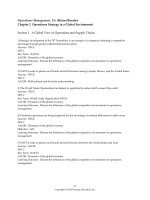Principles of hotel management
Bạn đang xem bản rút gọn của tài liệu. Xem và tải ngay bản đầy đủ của tài liệu tại đây (1.31 MB, 381 trang )
First Edition, 2009
ISBN 978 93 80075 73 0
© All rights reserved.
Published by:
Global Media
1819, Bhagirath Palace,
Chandni Chowk, Delhi-110 006
Email:
Table of Contents
1. Basics of Management
2. Funda
mentals
3. Salient Featu
r
es of Management
4. Significant Pri
n
ciples
5. Focu
s of Management
6. Hotel O
r
ganization
7. Manag
ement Dimensions
Basics of Management
1
1
BASICS OF MANAGEMENT
Human beings are by nature gregarious. Community or
group life has been one of earliest and most enduring features
of human existence on this earth. This natural phenomenon of
human beings living in groups have generated a variety of
groupings such as family, clan, community friendship group,
organisations, etc.
Organisations—business or social, dominate our lives. Our
activities and behaviour are shaped by these organisations right
from birth to death. Everyday of their lives human beings deal
with organisation. There is no escape from them. Hospitals,
schools, colleges, clubs, societies, local state and central
government, manufacturing and trading concerns are some of
the organisations we are associated with throughout our life.
Our association with some of them are close and long while
they are short lived or temporary with some others. The only
alternative may be a complete return to nature which very few
of us may choose. This association of human beings with
organisations dominates in every country irrespective of the
ideology and geographical differences.
2
Principles of Hotel Management
An organisation needs a system of relationship among
functions; it needs stability, continuity and predictability in its
internal activities and external contracts. It requires harmonious
relationship among people and processes.
All organisations have certain aims and objectives before
them for which they strive and do their best to achieve them
through their people who run and manage the affairs. In order
to define the roles of their members, their behaviour and activities,
they develop certain rules and regulations, policies, practices
and procedures. Organisations are thus made of objectives,
people, systems and procedures.
Different definitions of the organisation make it clear that
different scholars look upon organisation from different angles.
Some regard it as a mechanism to achieve certain objectives
by division of labour, authority and responsibility among its
members and coordinating their activities. Some regard it as a
network comparison of human relationships in groups. Some
others regard it as a system. These different approaches to
achieve its objectives are reflected in different organisation
theories which have developed certain principles to guide
managers in designing the organisation and making it an effective
instrument of meeting business goals.
In this block, we discuss different theories of the organisation,
i.e., Classical, Neo-classical theory, and Modern Organisation
theory.
ESTABLISHED WAY
The term “classical” in English language refers to something
traditionally accepted or long established. The beginning of the
classical organisation theory can be traced back to the heydays
of industrial transformation in the second half of the nineteenth
century when some perceptive observers felt obsessed with the
problem of growing size of the industries. In the beginning, the
large scale operations were carried out by the organisations
Basics of Management
3
with the help of unskilled and semi-skilled people but later on,
the technological development changed the industrial scene
completely. Many new economic, social and technical problems
sprang up. The need for solving these problems called for the
development of organisational forms and management practices
which were quite different from the traditional ones. This
phenomenon changed the individualistic nature of organisation
and management into mechanical nature. This view was current
till the first half of the twentieth century.
The classical writers viewed the organisation as a machine
and human beings as different components of that machine.
Their approach has focused on input-output mediators and
given less attention to constraining and facilitating factors in
external environment. Workers were considered to be driven by
economic considerations who could be solely motivated by
economic rewards. While managers were regarded as kind-
hearted, rational, intelligent and qualified people. Because an
organisation was treated as a machine, it was felt that its
efficiency could be increased by making each individual efficient,
so that both the organisation’s and the workers’ interests might
be served. Increased human productivity would facilitate the
organisation in achieving its goals and objectives while on the
other hand workers would get higher wages in return for their
increased productivity. Thus, management is to emphasise on
the improvement of machine in order to get higher productivity
from the people at the minimum expense. The emphasis was
on specialisation of performance and coordination of various
activities.
The classical theory was based on the following assumptions:
(i) The relationship between workers and management
was established through formal communications, defined
tasks and accountability and formalised procedures and
practices to minimise conflict between them.
(ii) Workers are considered to be driven by economic
4
Principles of Hotel Management
considerations who can be motivated basically by
economic rewards. Money is considered the main
motivator.
(iii) The managers were characterised as rational, kind-
hearted, intelligent and qualified personnel but they are
supposed to deal with the workers firmly in the system.
(iv) The theory assumes that the organisation is a machine
and the people its components. In order to make any
improvement in the whole system, internal factors were
considered and less attention was given on factors in
the external environment which may constrain and
facilitate the system.
(v) It has been assumed by the theory that both workers
and managers are rational. Workers can easily perceive
that their interests can be served only by increasing the
productivity and getting more wages for higher produc-
tivity, on the other hand, management gets the fruits of
higher productivity. Management tries to find out best
ways of doing a job by introducing new improvements
in machines and devoting time to such technical enginee-
ring and administrative aspect of organisation which can
make the man produce as much as he can with minimum
expenses so that workers can contribute more to the
organisation and earn more for themselves in return.
(vi) The theory puts special emphasis on error and
particularly on the detection of error and its correction
after it happens.
(vii) The theory assumes that man is relatively homogeneous
and unmodifiable while designing the jobs and in picking
the extra pairs of hands.
(viii) The classical organisation theory, in its essential
character, is centralised. The integration of the system
is achieved through the authority and control of the
central mechanism.
Basics of Management
5
Classical theorists were divided in opinion. The two streams
are scientific management and administrative management.
The scientific management stream of the organisation theory
emphasised on the efficiency of lower levels of organisation
while administrative stream focused on the efficiency of higher
levels. F.W. Taylor is called the father of scientific management
approach. Taylor and his followers insisted upon dividing and
sub-dividing the tasks through time and motion studies because
he was of the view that objective analysis of facts and collection
of data in the workplace could provide the basis of determining
the best way to organise the work. Thus, they investigated the
effective use of human beings in industrial organisations and
studied primarily the use of human beings as adjuncts to
machines in the performance of routine tasks. The approach
taken by this theory is quite narrow and encompasses primarily
psychological variables. As such this theory is also referred to
as ‘Machine Theory’ or ‘Physiological Theory.’
The scientific management group was mainly concerned
with the tasks at floor or operative levels, and these tasks were
quite different from other tasks in the organisation because:
(i) These tasks are largely repetitive in nature so that the
daily activities of a worker can be sub-divided in a large
number of cyclical repetitions of essentially the same
or closely related activities.
(ii) These tasks do not require any problem-solving activity
by the workers who handle them. Thus, more attention
was given in standardizing the working methods.
The second stream is the administrative stream of
organisation theory emphasises efficiency at higher levels. It
was concerned with the managerial organisation and process.
Henry Fayol was the leader for this group. He, for the first time
studied the functions and laid down principles of management
in a systematic manner for the guidance of managers. The other
contributors were Gulick, Oliver Sheldon, Mooney and Reliey,
6
Principles of Hotel Management
Urwick, Weber and others. The theorists have viewed the central
problem as being one where there must be identification of
tasks necessary for achieving the general purpose of the
organisation and of the grouping or departmentalising, to fulfil
those functions most effectively.
These two approaches are similar in recognising the fact
that organisation is a closed system, however, there are
differences between the two.
Scott and Mitchell have pointed out four key pillars on which
the classical organisation theory seems to have been built. They
are: 1. Division of labour, 2. Scalar and functional processes,
3. Structure, 4. The span of control.
Division of labour refers to the division of tasks of an
organisation into sub-tasks and then allot these sub-tasks or
sub-parts to individuals. The allotment should be in such a way
that each individual would have a small task so that he can
specialise himself in that part with a view to improve the efficiency
of the organisation while at the same time, the total of individuals’
tasks should add up to the organisation’s goals and objectives.
The approach rests upon the simple assumption that the more
a particular job is broken down into its component parts, the
more specialised a worker can become in carrying out his part
of the job and the more specialised he becomes, the more
efficient the whole organisation will be. This element is the
cornerstone among the four elements mentioned above because
other three elements are dependent upon division of labour.
The scalar and functional processes deal with the vertical
and horizontal organisation. The scalar process deals with the
vertical elaboration of an organisation. In other words, it is the
chain of command or the line of authority, along which authority
flows from the top (chief executive) to the bottom (first line
supervisor) and obligations and reporting from the bottom to the
top. Each one in the organisation is told who their superiors are
and who are their subordinates or to whom they are responsible
Basics of Management
7
and accountable in performing their job. Delegation of authority
flows from this line of command. The functional process deals
with the horizontal organisation, i.e., grouping of various functions
into units and clearly defining the relationship between the
various heads of the units. The grouping of functions can be
done on the basis of purpose, process, clientele, place and
time.
It refers to the logical relationship of functions in an
organisation arranged in order to accomplish the objectives.
These relationships are line and staff relationships. People,
departments, divisions and other segments of the organisation
that are authorised to determine the basic objectives of the
business and assess their achievements constitute the line. The
staff is that part of the organisation which assists and advises
the line on matters concerning it, in carrying out its duties. For
example, in a manufacturing concern, production is a line function
while personnel and finance are the staff functions.
In order to achieve the objectives, the managers are to get
the work done from the unlimited number of workers in a large
organisation. A manager cannot supervise an unlimited number
of people. The span of control refers to the number of subordinates
a supervisor can supervise effectively. Wide span yields a flat
structure whereas short span results in a tall structure. Graieunas
has developed a mathematical formula to show the numerical
limitations of the subordinates, a manager can control.
If an organisation is designed on the above principle, it will
look like a pyramid. At the top of the structure, there is head
of the organisation followed by the top executive, executives,
middle managers, junior managers and at the bottom the first-
line supervisors. Chain of command and line of communication
both flow from the top to the bottom in this structure. The line
of responsibility, however flows from bottom to top. There is no
provision of upward communication in this system except in
relation to the results of task performance.
8
Principles of Hotel Management
The classical theorists have developed certain principles of
organisations for the guidance of managers and executives and
they claim them as fundamental, essential, inevitable and
universal. Though divergence of views exists, there is a
considerable degree of unanimity on these principles. Fayol was
the first to give principles of administration. He developed a
comprehensive list of fourteen principles: (i) division of work;
(ii) authority and responsibility; (iii) discipline; (iv) unity of
command; (v) unity of direction; (vi) subordination of individual
interests to general interests; (vii) fair remuneration; (viii) equity
and a sense of justice; (ix) stability; (x) initiative; and (xi) teamwork
spirit. These principles are more or less have a considerable
degree of unanimity and some of these principles are still
applied in organisations.
The classical theory suffers from various limitations. It was
put under serious criticisms in the first half of the nineteenth
century by the neo-classical thinkers and others. The criticisms
are mainly based on the following grounds:
The classical theory is based on certain assumptions. These
assumptions were found unrealistic and hence not applicable
to organisations at a later date. The wrong assumptions, found
unrealistic are:
The classical theorists viewed the organisation as a closed
system, i.e., it has no environment and hence no interaction with
the outside world. They felt that the organisation structure could
be created as a house, i.e., step by step. They thought, once
the organisation is created, it would run smoothly and efficiently
because human beings are rational and they work more for
economic rewards. In this way, the model fails to consider many
environmental factors which influence upon the organisation
and, thus, this assumption leads to incomplete view of actual
organisational situations.
The classicists took a rigid and static view of the organisation
whereas an organisation is not static but dynamic. The
Basics of Management
9
organisation can instantly respond to changes in the environment
and adjust accordingly. The environment influences the
organisation and is influenced by it. The organisation imports
inputs, transforms them and export outputs to the environment.
The adjustments are necessary keeping in view the requirements
of the organisational environment and its various internal parts.
Thus, the best organisational pattern should meet the external
and internal requirements and these requirements are ever-
changing and dynamic.
A major criticism of the classical theory is that the assumption
regarding human behaviour was quite unrealistic. Human
behaviour is complex in nature and not as simple as was
established by the classical theorists. They lack sensibility to the
behavioural dimensions of an organisation and make over-
simplified and mechanistic assumptions for the smooth running
of the organisation, ignoring all complexities of human behaviour
at work. They assumed human beings as inert machines who
performs tasks assigned to them and ignored their social,
psychological and motivational aspects of human behaviour.
This assumption of classical behaviourists led the workers to
frustration, conflict and failure and thus subordinates man to the
organisation.
Human nature under this theory was also wrongly predicted,
Mason Haire observed that “there are implicit assumptions
about man on which classical organisation theory seems to me
to be based. He is lazy, short-sighted, selfish, liable to make
mistakes, has poor judgement and may even be little dishonest.”
The assumption that people at work can be motivated solely
through economic rewards is wrong. Several researches in
human behaviour have contradicted this assumption. Hawthorne
Experiments brought seven facts to light about several other
motivational and maintenance factors that motivate people at
work. Such other factors may be formation of informal groups,
emergence of leaders beyond the chain of commands,
10
Principles of Hotel Management
improvement in productivity linked with better status and job
enrichment, etc.
The theory was not only criticised for its certain assumptions
that are unrealistic in modern industrial world but its certain
principles formulated by classical theorists were also criticised.
The main criticisms of classical principles are as follows:
Its various concepts and principles are developed by
practitioners in management which are mainly based on personal
experience and limited observation. They (principles) lack
precision and comprehensive framework for analysis. No scientific
method was used. Moreover, it is not clear whether these
principles are action recommendation or simply definitions.
Certain independent specifications are to be made in
understanding the meaning of an organisation. The classicists
have referred to the advantages of various organisational
arrangements, their arguments are one-sided and they offer no
objective criteria for selecting one method over other methods.
March and Siman observed, perhaps the most crucial failure
of the administrative management theory is that it does not
conform to the practice. The theory tends to dissolve when put
into testable form. Thus, not a single principle is applicable to
all organisational situations and sometimes contradicts each
other.
The classical theorists have claimed that these principles
have universal application. This suggests that these principles
can be applied in: (i) different organisations, (ii) different
management levels in the same organisation, and (iii) different
functions of the same organisation. The empirical researchers,
however suggest that none of the principles has such
characteristics. Moreover, there are many principles which are
actually contradictory with other principles. For example, principle
of specialisation is quite in conflict with the principle of unity of
command. The following are certain classical principles which
are invariably questioned:
Basics of Management
11
The classical theory is based upon the hierarchical
structure that establishes the authority relationship
between individuals in an organisation. It refers to
arrangement of individuals in superior-subordinate
relationship. Today, the institutions of hierarchy based
upon position within the organisation is being
discounted and the technological specialisation with
authority of knowledge is gaining importance.
The classical theory suggests that each person has one
superior. This principle has now become outdated. The trend
is changing and the organisation seeks help from other members
who are not in their chain of command, such as staff personnel.
The organisations formally provides such supervision and the
members thus, work under multiple command instead of under
unity of command.
The classical theorists have focused excessive reliance on
the strength of four key pillars, i.e., division of labour, scalar and
functional process, structure and span of control. The neo-
classicists who do not entirely reject the principles of classical
theory, have attacked these key pillars. Some of the more
important points raised by them are:
Division of labour is one of the key pillars of the
classical theory but this tenet is criticised on the
ground that there is no exclusive basis for grouping
products, process, person or place, can always be
used. The considerations of expertise and economy
warrant different approaches in different situations.
Besides, division of labour cause depersonalisation
of work at the operative level which results in loss
of human relationships. Moreover, despite the fact
that there is division of work among individuals and
even though they may work independently of each
other, the unit to which they belong specialises in
a particular activity and its interdependence causes
12
Principles of Hotel Management
stresses and strains. Because these individuals and
units work for common goals it raises a serious
problem of coordination so that work may be done
efficiently, cooperatively and harmoniously. As
executive of each unit is answerable to the goals set
for his unit, he internalises his sub-unit goals resulting
in jealously guarded functional segments in the
organisation.
Division of labour, moreover, causes several human problems
of work. Due to limited repetitive tasks, the workers feel boredom,
monotony, psychological alienation, etc. It also fails to utilise
multiple capacities of people. The theory ignores human values
such as satisfaction of job.
The scalar and functional process raises another problem
of delegation of authority and responsibility. It is assumed that
the rational personal programme will help in selecting the
personnel having capacities matching authority and responsibility
in a particular position. But the neo-classicists are of the view
that there is no measuring rod for measuring the capacity.
Besides, in an organisation, only capacities do not work, there
are so many other kinds of overlays which affect decision-
making process. Moreover, as March and Siman have pointed
out, in most organisational situations, people are not looking for
any optional solution but they require ‘satisfying’ solution, i.e.,
solution that meet the requirements.
Classicists have laid down certain principles which, if followed
will lay down a neat and perfect organisation structure, but the
human behaviour disrupts the best laid organisation plans.
Research showed that major conflicts between line and staff
personnel in the organisation were experienced because jobs
are becoming increasingly specialized have requiring a higher
knowledge context. It can be felt if everything had worked in a
predetermined way, there would have been no need of specialised
control agencies, or organisation structure and it was the only
cause for the development of control agencies.
Basics of Management
13
The classical approach suggests a narrow span of control
specifying the number of subordinates to 5-6 at higher level and
20 at bottom. But the view of neo-classicists favour a wider span
of control having a large number of subordinates under one
supervisor. According to them, there are several considerations,
such as the abilities of supervisor and subordinates, nature of
work, time schedules, geographic dispersion, etc. The ability to
handle the responsibilities increases with the increase in level
of education.
Weber’s ‘ideal’ bureaucracy, the main constituent of the
classical theory, suggests the strict adherence to rules and
regulations through mindless application of the letters of the
rule. The scope for individual initiative and contribution to the
organisation goal is thus limited. The result is red-tapism and
observation of rules and regulations becomes the main objective
and the objectives for which these rules and regulations are
formed, are forgotten. Robert K. Morton has rightly observed
that the rules and procedures may take positive values and
become ends rather than means to ends and the decision-
making tends to become a routine application of precedents
with little attention to alternatives not previously experienced.
Today when problem-solving ability, innovativeness and creativity
are required, the bureaucratic approach appears to be
inadequate.
The classical theory is devoted to specialisation of different
parts of organisation to maximise output with the use of minimum
input. The classicists concentrate their views along with the
division of labour, organisation structure, grouping of activities
and span of control, etc. but not with its effects on the
interrelationships. It is a need model and assumes action and
communication will flow uninterrupted.
They do not envisage the development of informal groups
and their leaders who control the behaviour of their members.
According to neo-classicists, there is no scope for emotions and
14
Principles of Hotel Management
sentiments and no conflicts due to elaborate job descriptions,
policy specifications, rules and regulations, clear-cut authority
and responsibility, etc. under the classical theory. In this way,
it recognises tasks and not the people.
The theory provides little scope for integrating people with
the organisation. The goals are set at the top without consulting
the subordinates who are actually, the real executors. The
decision-making is highly centralised. The theory concentrates
too much of authority at the top as the people at lower level
are considered to be the ‘inferior lot.’
The various criticisms of the classical organisation theory
should not lead one to feel that it is a useless theory and does
not offer any guidance for managerial action in an organisation.
In fact, still there are many classical principles which are applied
successfully in many organisations. It shows that though not
much, the classical theory has its validity in designing an
organisation. Scott observes, “It would not be fair to say that
the classical school is unaware of the day-to-day administrative
problems of the organisation. The classical organisation theory
has relevant insights into the nature of an organisation, but the
value of this theory is limited by its narrow concentration on the
formal anatomy of the organisation.”
FRESH LITERATURE
The classical organisation theory focused attention on
physiological and mechanical variables of the organisational
functioning in order to increase the efficiency and productivity.
But positive aspects of these variables could not produce the
positive results in work behaviour and the researches tried to
investigate the reasons for human behaviour at work. They
discovered that the real cause of human behaviour is somewhat
more than the physiological variable. These findings generated
a new phenomenon about the organisational functioning and
focused attention on human beings in the organisations. These
Basics of Management
15
exercises were given new names such as ‘behavioural theory
of an organisation’, ‘human view of an organisation’ or ‘human
relations approach in an organisation.’
The neo-classical approach was developed as a reaction
to the classical approach which attracted so many behaviourist
to make further researches into the human behaviour at work.
This movement was started by ‘Mayo’ and his associates at
Hawthorne Plant of the Eastern Electric Company, Chicago in
the late twenties, gained momentum and continued to dominate
till the sixties. An impressive account of thinking of human
relations has been given by Douglas M. McGregor in his book
entitled ‘The Human Side of Enterprise.’
The classical theory was the product of the time and the
following reasons were responsible for its development:
(i) The management thinking was showing signs of change
because of the improved standards of living and
education level. The technological changes were forcing
the management to expand the size of the organisation
and complexities were increasing. This also led to the
fact that the management be somewhat more
sympathetic and considerate towards their workers.
(ii) The trade union movement got momentum and made
the workers conscious of their rights. It was no longer
possible for the management to treat the human beings
at work as ‘givens’.
These were two main reasons which were responsible for
the change of management behaviour from autocratic to the
custodial approach which was based on offer of fringe benefits
apart from wages to meet their security needs.
Though neo-classical approach was developed as a reaction
to the classical principles, it did not abandon the classical
approach altogether, rather it pointed to the limitations of the
classical approach and attempted to fill in the deficiencies through
16
Principles of Hotel Management
highlighting certain points which were not given due place in
the classical approach. In this regard, there were two schools
of thought—one school of thought with writers as Simon,
Smithburg, and Thompson, pointed out the limitations of the
classical approach to structural aspect only and the analysts
called this group as ‘neo-classicists’. This school of thought
suggested modifications to the classical principles but did not
abandon the basic principles. The other school of thought which
consisted of large number of writers focused on the human
aspect neglected by the classicists. This group was called as
human relationists or behaviourists. Both these schools were
reactions to the classical theory but failed to suggest or develop
any new theory except providing some points of criticism on
varying counts. Both of them could be referred as neo-classicists.
Neo-classicists, endeavoured to identify the weaknesses of
classicists through empirical research and most of the criticisms
of classical theory have emerged through researches. Howthorne
studies were the beginning of the series. The other contributors
are Roethlisberger, Dickson, Whitehead, Lippitt and White, Coach
and French Jr., etc.
Neo-classical approach is based on two main points:
(i) Organisational situation should be viewed in social as well
as in economic and technical terms, and (ii) The social process
of group behaviour can be understood in terms of clinical method
analogous to the doctor’s diagnosis of human organism. The
neo-classicists view organisation as combination of formal and
informal forms of the organisation. The informal form was missing
in classical approach. They also introduced behavioural science
to diagnose human behaviour and showed how the pillars of
classical doctrines—division of labour, functional processes,
structure and scalar chain are affected and modified by human
actions. The main prepositions of neo-classical organisation
theory are as follows:
1. The organisation in general is a social system composed
of numerous interacting parts.
Basics of Management
17
2. The social environment on the job affects the workers
and is also affected by them. Management is not the
only variable.
3. The informal organisation also exists within the
framework of formal organisation and it affects and is
affected by the formal organisation.
4. There is always a conflict between organisational and
individual goals that always increases the importance
of integration between these two.
5. People are interdependent and their behaviour can be
predicted in terms of social factors.
6. Money is one of the motivators but not the sole motivator
of the human behaviour. Man is diversely motivated and
socio-psychological factors are more important.
7. Man’s approach is not always rational. He behaves
irrationally as far as rewards from the job are concerned.
8. Both-way communication is necessary because it carries
necessary information downward for the proper
functioning of the organisation and transmits the feelings
and sentiments of people who work in the organisation
upward.
9. Teamwork is essential for cooperative and sound
functioning of the organisation.
The neo-classical theory provides various modifications and
improvements over the earlier theory and offers a more
humanistic view towards people at work. Neo-classicists have
also introduced behavioural science in the study of organisational
functioning which has helped managers quite a lot. This approach
emphasised the micro-analysis of the human behaviour. The
theory has brought into light certain important factors which
were altogether ignored by the classicists such as informal
group, group norms, informal leader, non-economic rewards,
etc. Thus, the approach gives evidence of accepting the
classical doctrine though superimposing its modifications,
18
Principles of Hotel Management
resulting from individual behaviour and the influence of the
informal group.
The main criticisms of the neo-classical theory are as here
under:
Certain assumptions on which the neo-classical
theory is based do not seem to be true. For example,
the assumption that there is a solution to every
problem which satisfies everyone in an organisation
is not true. Often there are conflict interests among
various groups in the organisation that are structural
and not merely psychological.
The various formats and structures of organisations given
by neo-classicists are not universal. Their application is limited.
There is no particular structure which may serve the purpose
of all the organisations. It also overlooks some of the
environmental constraints which managers cannot ignore and
this lapse makes the practicability of the theory limited.
The theory lacks the unified approach of the organisation
theory. In fact, it is not a theory at all. All that was done in neo-
classical theory is simply modification of the classical theory
rather than organisational transformation. So, this theory has
almost the same limitations as the classical theory.
The theory gives too much emphasis on human aspects in
the organisation. As the classicists concentrated on structural
aspect, neo-classicists concentrate their attention on the human
aspect. It ignores the other aspects such as formal structure,
discipline, etc.
Some thinkers while criticising the theory have called it
bankrupt because it suggests nothing new. Though, the theory
has offered valuable contributions to the lore of organisation like
the classical theory, it suffers from incompleteness, a shortsighted
perspective and lack of integration among the many factors of
human behaviour studied by it.
Basics of Management
19
Howthorne studies at the Western Electrical Company,
Chicago was the main source of inspiration to the neo-classical
school. Mayo and his associates carried out several experiments
there, by providing better working and living conditions and
financial incentives, and they got amazing results. Productivity
and efficiency went up considerably. The following facts were
uncovered by these experiments:
1. The individual roles as defined and norms established
by their social system differ from those of the formal
organisation. Workers follow the social norms rather
than try to achieve the target management thinks they
can achieve even though this would have helped them
earn better and as much as they physically can.
2. Non-economic rewards and social sanctions also play
quite a significant role in guiding the behaviour of the
workers. It is their perception of the situation that matters
and not that of the management. They fear retaliation
for violating the group norms. So, they follow group
norms and are not motivated by the economic incentive
plans.
3. The group plays an important role in determining the
attitudes and performance of individual worker. Often
workers do not act or react as individuals but as a
member of their group. A worker can more readily accept
the change in his behaviour if the group of which he is
a member changes its behaviour.
4. Informal leader and not the formal leader, i.e., the formal
incharge of the group as supervisor or manager, sets
and enforces the group norms. Formal leader is proved
ineffective unless he conforms to the norms to the group
of which he is incharge.
5. There is need for communication between the ranks
participation in decision-making and democratic
leadership. It explains to the lower participants as to why
20
Principles of Hotel Management
the management has taken a particular decision. The
lower ranks are allowed to share in the decisions taken
by the higher management especially in matters
concerning them. Thus, suggesting that the management
is just, non-arbitrary and concerned with the problems
of workers and not only with the work output.
6. Increasing satisfaction leads to increased organisation
effectiveness.
7. The management should possess not only technical
skills but also effective social skills.
8. People are motivated in the organisation not merely by
the satisfaction of lower needs but by fulfilling certain
higher level needs.
The above conclusion of Hawthorne Experiments received
a wide publicity and they changed the attitude and the thinking
of the management significantly. This approach was further
persuaded relentlessly by behaviourists.
We may look at the organisation from two different angles:
1. We may consider the overall picture of the organisation
as a unit; or
2. We may consider the relationship between its various
internal components.
When we consider the overall picture of the organisation,
we consider all the elements—internal and external—and their
effects on each other simultaneously. This approach may be
called the ‘goalistic view’ because it tries to reach the goal of
an organisation by unifying the efforts of all the elements. For
example, when we consider finance, workers and their attitude,
technological developments, etc. we are following goalistic view.
It serves as a mean-ends analysis which in turn facilitates
division of work and helps in judging the extent of success of
comparing actual and targeted performance. But it does not
answer many problems such as interdependence of elements,
Basics of Management
21
organisations environment, interface, etc. It gives a systematic
view when we consider the second approach, i.e., we examine
the relationship between each element of the organisation and
their interdependence. If we examine employer-employee,
customer and organisation, debtors-organisation relationships,
we follow systematic view.
The systems approach focused attention on the following
aspects:
(i) It integrates all elements for the proper and smooth
functioning of the organisation.
(ii) The organisation overall goals can be achieved
successfully because it considers all the aspects of the
problems deeply and maintains a harmonious
relationship between various elements so that they work
unitedly to achieve goals.
(iii) The approach helps in acquisition and maintenance of
various resources, i.e., man, material, money, and
machinery, etc. for pertaining the smooth functioning of
the organisation.
(iv) It allows adaptation to internal requirements and
environmental changes in order to survive and grow.
Kast and Rosenzweig define the system as an organised
unitary whole composed of two or more interdependent parts,
components or sub-systems and defined by identifiable
boundaries form its environmental suprasystem. More simply,
a system may be referred as units composed of several
interdependent parts. System may be denoted as a grouping
of parts and not simply an agglomeration of individual parts.
Though each part performs its own functions yet they work
towards a common goal. The behaviour of the entity is a joint
function of the behaviours of the individual parts and their
interactions. For instance, a human body may be regarded as
a system, consisting of several sub-systems, such as circulatory,
reproductive digestive, nervous systems, etc. Even though each
22
Principles of Hotel Management
sub-system performs different and distinguished function, they
depend on each other. Similarly, an organisation is composed
of a number of sub-systems of sub-systems such as internal
organisation, technological, psychological, structural, managerial
and environment etc. which are constantly changing and evolving.
A change in one may affect the other.
From the analysis of foregoing definition and discussion
following characteristics of a system emerge:
A system has several parts. Each part is dynamic
and affects all other parts. They are interrelated and
interdependent. Interdependence of different parts
is must in an organisation as a system because of
division of labour, specialisation, sharing of limited
resources, scheduling of activities, etc. The work of
the organisation is divided into various departments,
sub-departments and so on, assigning each unit an
independent specialised task, which on integration
culminates into the accomplishment of overall
organisational goals. These parts are interconnected
in such a way that a change in one part may affect
the other part and in this way, the whole organisation.
A system is composed of several sub-systems. For example,
in a manufacturing organisation, total manufacturing is one
system, within which may exist a complete production system
which again may contain an inventory control system. Conversely,
a system or sub-system may form part or container of other
system. For example, an individual who may be a part of one
system, may also be a part or container for another physiological
system.
Every system may be distinguished from other systems in
terms of objectives, processes, roles, structures, and norms of
conduct. So, every system is unique if anything happens in the
organisation, we regard it as an outcome of a particular system
and we locate the fault in the system.









